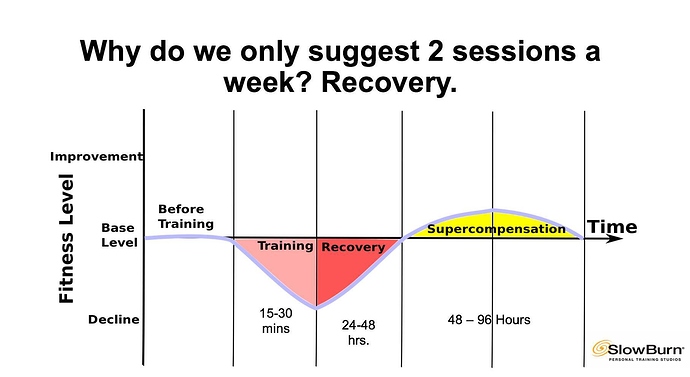Here’s a great FB post and chart from Slow Burn author Fredrick Haan.
If you’re interested in getting maximum results in the minimum time you’ll like his work. He argues for a whole body (versus spilt routines where you do different body part exercises on different days) workout done twice a week. Each whole body session lasts between 15 and 30 minutes. He uses low-momentum super-slow single-set compound-exercise-only technique. One key difference is that his single set (“Set” describes each attempt to do a number of repetitions or sustain a weight.) lasts about 50-100 seconds which is 3 to 4 times the time taken for a traditional weight lifting set of faster moving 5-10 reps.
If you look at the graph you’ll see that muscle adaptation occurs in the “Supercompensation” period 2 to 4 days after the workout, not during the workout. Doing more strength exercises of the same body parts during this phase is counter-productive.
Of course this does not prevent you doing “physical activities” like walking, cycling, dancing, playing sports etc… which all have health and emotional benefits.
Protagonists will argue “If I do more reps and/or sets and more often I’ll get even better results.” I won’t get into this argument as I believe that the routine that you believe in and have time for is likely the routine you’ll stick to and that will work better than the one you don’t stick to.
But if you can’t or don’t want to allocate much time to exercise, or want to try something different, then super-slow single-set high-intensity training is safe and effective for all ages. It can be done in the gym, the park or at home with body-weight exercises (as promoted by Dr Ted Naiman).
PS: My routine is just as Fred recommends except my “rest between sets” is one week! I only go to the gym for 30 minutes on Sundays. But I do enjoy some functional exercises at home, do laps sometimes and either go for a cycle or morning walk that includes 5 sets of some decent stairs in the park.




